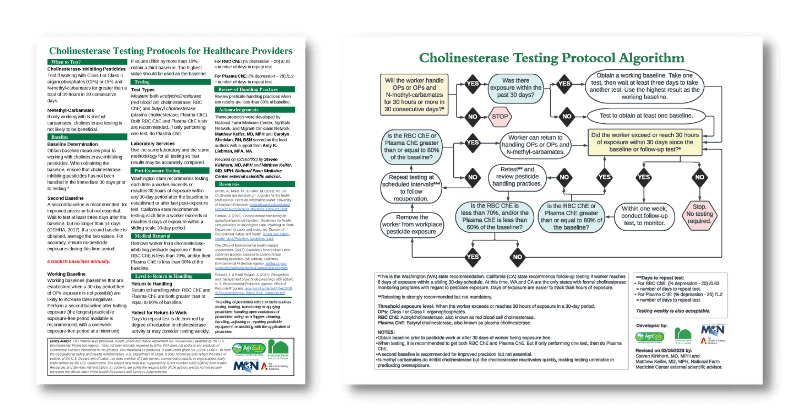
These Cholinesterase (ChE) clinical tools provide a concise and simple format to guide clinicians in monitoring the ChE levels for patients working with Class I and Class II organophosphates (OP) or OP and N-methyl-carbamates.

These Cholinesterase (ChE) clinical tools provide a concise and simple format to guide clinicians in monitoring the ChE levels for patients working with Class I and Class II organophosphates (OP) or OP and N-methyl-carbamates.

MCN and Farmworker Justice offer these guides to assist clinicians in understanding farmworker health and safety regulations. OSHA’s Field Sanitation Standard; EPA's Federal Insecticide, Fungicide, and Rodenticide Act (FIFRA); EPA's Food Quality Protection Act (FQPA); EPA’s Worker Protection Standard (WPS).

MCN y Farmworker Justice ofrecen estas guías para ayudar a los médicos en la comprensión de regulaciones de salud y seguridad de los campesinos. Información de los Estándares de Saneamiento de la Administración de Seguridad y Salud Ocupacional (OSHA) para los campos; la Ley Federal de Insecticidas, Fungicidas y Rodenticidas (FIFRA) regulado por la Agencia de Protección Ambiental (EPA); la Ley de la Protección de la Calidad de los Alimentos (FQPA) también regulado por el EPA; y el estándar de protección del trabajador (WPS) establecido por el EPA.

MCN and Farmworker Justice offer these guides to assist clinicians in understanding farmworker health and safety regulations. OSHA’s Field Sanitation Standard; EPA's Federal Insecticide, Fungicide, and Rodenticide Act (FIFRA); EPA's Food Quality Protection Act (FQPA); EPA’s Worker Protection Standard (WPS).
The U.S. Environmental Protection Agency’s (EPA) Worker Protection Standard (WPS) provides basic workplace protections to farmworkers and pesticide handlers to minimize the adverse effects of pesticide exposure. EPA announced major revisions to the WPS in September 2015. MCN and FJ's fact sheet provides a summary of the revised regulation.
In 2015, for the first time in over 20 years, the Environmental Protection Agency updated the Worker Protection Standard (WPS). The WPS provides basic workplace protections for agricultural workers to reduce the risk of pesticide exposre. This issue brief overviews the major revisions that are particularly relevant for clinicians caring for agricultural workers.
Three concise and effective environmental/occupational health screening questions for the primary care provider. English and Spanish. MCN, 2014.
An EHR-friendly version of these screening questions was developed through MCN's Workers & Health Program. This can be used as a reference for integration into the health center's Electronic Health Record.
Introduction
In August of 2005, the North Carolina Division of Public Health, Occupational and Environmental Epidemiology Branch (OEEB) was notified that three women who had worked on farms in North Carolina owned by Ag-Mart had delivered infants with birth defects. All three births took place in Florida where the women also worked on Ag-Mart farms and lived near each other. This report summarizes the OEEB’s investigation and assessment of the pesticide exposures likely experienced by these women while in North Carolina.
Haz-Map® is an occupational health database designed for health and safety professionals and for consumers seeking information about the adverse effects of workplace exposures to chemical and biological agents. The main links in Haz-Map are between chemicals and occupational diseases. These links have been established using current scientific evidence.
Emergency Medical and Field Fumigation Guides for Methyl Bromide, Methylisothiocyanate (MITC), Chloropicrin, and Metam Sodium/Metam Potassium.
http://www.farmworkercliniciansmanual.com
This comprehensive manual was developed by the New York Center for Agricultural Medicine and Health and the Migrant Clinicians Network for the diagnosis and treatment of occupational injuries in migrant and seasonal farmworkers. The information in the manual does focus on agricultural occupations in the Northeast.

These Cholinesterase (ChE) clinical tools provide a concise and simple format to guide clinicians in monitoring the ChE levels for patients working with Class I and Class II organophosphates (OP) or OP and N-methyl-carbamates.
MCN's Pesticide Clinical Guidelines and Pesticide Exposure Assessment Form assist in the recognition and management of acute pesticide exposures in primary care settings.
The pesticide guidelines were adapted from guidelines developed by Dr. Dennis H. Penzell, a former medical director of a Community and Migrant Health Center with experience in large-scale pesticide exposure incidents.
The Acute Pesticide Exposure Form was adapted from the data collection on an acute pesticide exposed patient tool developed by Matthew C. Keifer, MD, MPH, Director of the National Farm Medicine Center, appearing in the EPA's Recognition and Management of Pesticide Exposures, 6th Edition, EPA 2013.
These resources were developed with guidance from MCN's Environmental and Occupational Health Advisory Committee - a panel of healthcare professionals and researchers with expertise in pesticides and migrant health.
The following documents are a collection of the best resources available for taking a good occupational health history.
Use the link below to access MCN's Rapid Assessment Tool to help adolescent farmworkers identify agricultural tasks they perform in agriculture and facilitate clinician understanding about the health risks associated with it. Youth worker images are adapted and reproduced with permission from the National Children Center for Rural and Agricultural Health and Safety. Images copyrighted through Marshfield Clinic, Marshfield, Wisconsin.
If computers and internet access are unavailable where patient care is provided, the worker assessment sheet and clinician information grid are available in PDF.
A useful resource for health professionals interested in the health effects of exposure to specific chemicals and hazardous substances.
Objective, science-based information about pesticides - written for the non-expert.
Outlines the knowledge and skills that health professionals need to have about pesticides. This document is part of a national initiative aimed at ensuring that pesticides issues become integral elements of education and practice of primary care providers. English and Spanish